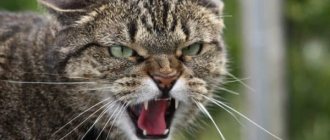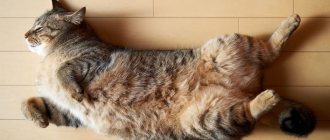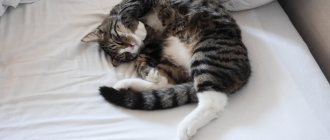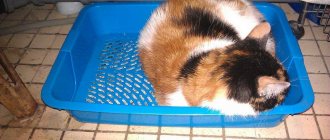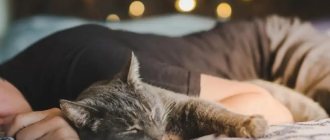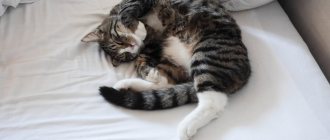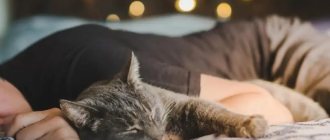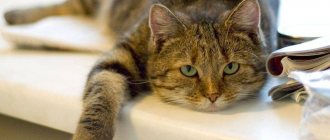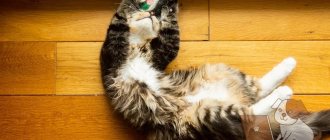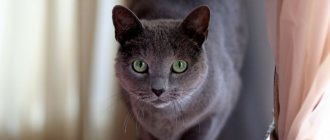It is impossible to resist the charm of a pet when it rolls over on its back and looks at you with big, soulful eyes. What could be cuter than his fluffy belly? It seems that this pose was given to the cat by nature specifically in order to make a person admire and be touched.
After taking a photo of your adorable pet and reaching out to pet its belly, you suddenly find its teeth and claws digging into your hand. A second - and the cute fluffy turns into a wild cat. Such rapid changes in the behavior of the animal cause bewilderment among their owners.
The motives that cause a cat to roll over are different. Knowing them, you can predict its reaction to human affection - whether the animal will receive pleasure or respond with aggression. Below are reasons why your pet may lie on its back. By studying them, misunderstandings can be prevented.
Pose of trust
The abdomen is one of the most sensitive parts of a cat's body, where most of the vital organs are located. Therefore, in times of danger, the animal will primarily protect this area and head.
A pet lying on its back, exposing its belly, demonstrates submission and trust. Signs of insecurity also include splayed hind legs, a relaxed tail, and a calm gaze. In this state, the cat may begin to purr, and it will not nervously twitch its tail or run away when trying to pet it.
Adopting a vulnerable position means that the animal feels that there is no threat and gives the owner access to its belly, including for stroking. At this time, it is important to assess the condition of your pet. Calmness after touching is a good sign that can be seen as an invitation to further communication. To justify the trust placed in you, you should interact with your furry friend gently and carefully.
Why do cats sleep in place or on their owner's things?
For humans, spending time with a pet like this is not dangerous, so there should be no cause for concern when sleeping together. Cats love the smell of their owner and everything that he emits, so the animal does not miss a single opportunity to lie next to a person.
Negative aspects
You should not sleep with an animal on the same bed in the following cases:
Restless sleep
When a person often tosses and turns, turns from one side to the other, you can inadvertently crush the paw or tail of an animal. In addition, cats sleep soundly and may not find their way in time.
In this case, it is better to give your pet a separate sleeping area; Allergy to wool. Some people react particularly sharply to cat hair, they begin to sneeze, runny nose, and exhibit other allergic symptoms; Woman's pregnancy. It is recommended to wean your pet from the habit of sleeping on the same bed with its owner, since when the child is born, he will constantly be next to his mother;
Birth of a baby. The proximity of a cat and a baby on the same bed is not recommended in order to avoid injuries from both the child and the pet. If a cat walks outside during the day and sleeps at home at night, it is worth limiting his access to the master’s and children’s beds, as he can bring home an infection or some parasites, infecting the baby.
You can wean your cat from sleeping on the bed if you provide him with an equally comfortable and warm sleeping place. There are recommendations to help train your animal to sleep separately:
- A prepared bed or a special house should be installed in the favorite part of the apartment, where the pet likes to spend a lot of time;
- A small kitten should be placed in a new place for familiarization. In order to attract attention to it, a bait such as catnip is suitable;
- If the cat already has a rug, you need to put it on the bed, then there should be no problems with relocation. For a pet, the owner’s old T-shirt or pants can be his favorite, which should be laid out in his house;
- It is recommended to close the bedroom door before going to bed. Don’t pay attention to your pet’s plaintive meow; after a while he will understand that he won’t be allowed in and will get used to sleeping in a new place.
How to organize
It is important for a cat that its sleeping place is not only cozy and warm, but also clean, which is why they choose their owner’s bed. In some cases, furry pets climb into the linen cabinet or closet where washed bedding is stored
The owner should take into account that cats like to sleep on an elevated place, and not on the floor, like dogs. This gives them a feeling of security. Cats try to choose quiet, preferably dark, places to sleep so that none of the household members disturbs their peace. It is for this reason that animals prefer to hide and sleep in boxes, closed on all sides from light penetration.
The organization of the berth is carried out taking into account the following recommendations:
- For these purposes, a large box or a spacious basket is suitable, which can be placed near the radiator in winter, and a soft bedding can be laid inside;
- Convenient location. The owner must place the sleeping place in such a way that the cat can have a good view of the owner and everything that is happening around him. It is also not recommended to place the basket too high so that the cat can easily climb into it and go to bed;
- The bedding should be made of fabric that is pleasant to the touch. If desired, you can put a small pillow in the basket.
When the cat gets used to sleeping in a place organized for him, sometimes old habits can appear, and the pet will again be found in the owner's bed. You should not scold or punish an animal; its behavior is nothing more than a manifestation of passionate feelings of love and affection for a person.
Cats are one of a kind - unique and inimitable. They are difficult and not as good-natured as other pets. Therefore, every act of a cat can be explained. Why do cats sleep in place or on their owner's things?
- Our clothes store body odor. The cat wants to appropriate it for himself in order to be closer to the owner and have a close relationship with him. The cat quickly masters the new territory, and then it considers it its own. She also needs to make her owner's things her own. By this she shows that she trusts her owner and shares her cat life with him.
- Our clothes retain the smell. Cats climb on things to feel safe. She feels as if she is sitting on her owner's lap.
- From an esoteric point of view, this fact can be explained by the fact that the cat loves to collect bad energy. The animal lies on clothes, collecting negative energy waves that have accumulated on things during the working day from stress or bad thoughts.
Evil intent
Sometimes a cat is forced to lie on its back by “insidious thoughts.” A sudden jump to the floor can signal that the animal is angry, so before approaching, you should try to read what her body is “saying.”
The tail is a reliable indicator of a cat's mood. Quick movements from side to side signal an increased level of activity: it is time for play (but not for petting). Some pets manage to place their tail between their paws and on their stomach to use it as a built-in toy.
A cat's eyes can tell a lot about the mood of the owner . A glittering gaze following your every move indicates that you have become a target. At this time, the cat's paws begin to twitch and you can see how the animal tries to make several tentative movements towards the intended prey. Active behavior is accompanied by purring or a series of short sounds - this is how the cat lures you.
You should avoid touching an animal lying on its back and intending to play. It is better to postpone attempts to scratch the tummy until later, and instead bring a toy (a stick or a soft object) and, after teasing your pet, watch how he playfully releases his claws.
What to do if your cat is limping with fractures and bruises
A cat's paw bruise is not uncommon, especially in young cats. During play, kittens actively run and jump, which can result in injury. The bruise does not threaten the life of the animal, but requires treatment to avoid inflammation.
You cannot do without medical help here.
Fractures and bruises: how to recognize and what to do
The first sign of damage is that the animal holds the affected paw up and does not step on it. If it occurs occasionally, he tries to transfer the body weight to a healthy limb as soon as possible. A bruise can be identified by the following symptoms:
- hematoma in the injured area;
- swollen paw;
- impaired gait with lameness;
- absence of skin wounds;
- absence of displaced joints;
- local temperature increase;
- constant licking of the sore spot (the animal massages the paw with its tongue, accelerating the resorption of the hematoma);
- aggressive behavior when the owner tries to touch the damaged limb.
Fractures have their own distinctive features:
- swollen paw along the entire length, and not just at the site of injury;
- when palpating (feeling) the paw, a displacement of the joints or bones is felt;
- the animal does not attempt to step on the limb;
- due to severe pain, the pet constantly meows;
- the structure of the paw is damaged.
If an animal is bruised, you must first calm it down by picking it up and gently stroking it for several minutes. Then apply cold to the bruised area - a cloth in which ice is wrapped or a towel soaked in cold water. You need to apply it for 1 minute, then take a break for half a minute, and then repeat the procedure again. This must be done for 15 minutes.
A couple of hours after injury, you can do an alcohol rub. You should not put too much pressure on the sore spot - this will cause anxiety and stress in the cat. An alcohol compress can be applied to a calm animal, which effectively relieves swelling and pain.
Be sure to read: Why does a cat lick under its tail until it becomes bald - it can be dangerous! In case of a fracture, it is necessary to provide maximum rest to the animal, place it in a carrier or take it to a bed. The diseased limb must be fixed to avoid displacement of bones and joints, and then urgently taken to a veterinary clinic.
If your pet is suspected of having a spinal fracture, you should move it as carefully as possible onto a rug or blanket, take it to the car and take it to the veterinarian as soon as possible. Any displacement of the vertebrae can result in spinal cord damage
If the jaw is broken, it is necessary to put a muzzle on the cat - this will protect it from shifting bone fragments that threaten to rupture the soft tissues.
Patella luxation
Patella, or dislocation of the stifle, is uncommon in cats. The main reasons for its appearance are severe injuries or genetic abnormalities. The disease occurs suddenly: the animal experiences severe pain, cannot move normally, limps, and reacts to stroking with hissing and aggressive behavior. The pet constantly meows, he is scared. In such a situation, they act immediately - the animal is urgently hospitalized.
Relaxation
Each member of the cat family has a favorite sleeping position. Some people prefer to curl up into a ball, while others prefer to stretch out on their sides. There are individuals for whom there is nothing more relaxing than lying on their back.
Sometimes cats fall asleep on their side, and when an “unconscious” state occurs, they roll over onto their back. It happens the other way around: while resting in a belly-up position, the animals feel so good that they begin to doze off. No matter when your furry friend ends up on his back, this position always causes affection.
It is usually quite easy to understand that your pet is resting while lying on its back: its paws are relaxed, its eyes are closed, its breathing is slow, and you can even hear quiet snoring.
Trying to wake a cat often provokes an aggressive reaction, even if it is resting in a protected position. Being in a vulnerable position (with its belly exposed), the animal will wake up and begin to defend itself. It is better not to disturb a pet sleeping on its back at all, but to postpone communication until it wakes up.
When to worry
Sometimes sleeping on its back causes the animal to spread its legs wide. Sometimes this is a sign of a serious pathology. A visit to the veterinarian and diagnostic testing are recommended for pets with the following symptoms:
Frequent trips to the toilet are the first sign that something is wrong with the animal.
Apathy and indifference to external stimuli are dangerous signs that indicate the active activity of pathogenic microflora in the body of cats. In some cases, the problem is associated with helminths and intoxication of the body from their waste products.
Possible diseases
There are a number of pathologies that lead to unusual postures in animals. Common diseases:
If the above signs appear, there is no need to self-medicate and diagnose your sick pet. Attempts to palpate the abdomen will lead to severe aggression with scratching and biting. Diagnostics in a veterinary clinic will help to recognize the ongoing pathological process and find the best method of therapy.
Ready for love
When a female lays on her back during estrus, this may be a demonstration of her readiness to mate, especially if a male cat is nearby. The “love mood” is also confirmed by intense loud sounds and the desire to sneak out of the house. This behavior is not typical for sterilized individuals; If this is your case, then when you see a cat lying on its back, you should not worry that it is waiting for love.
During estrus, the female is more sensitive and unpredictable, so you should not disturb her belly by touching - this will cause irritation and even aggression (the animal may scratch or bite). It's best to put off tummy rubs until your cat is in heat and calmer.
Self-defense
The cat does not show its belly if it senses danger. However, at times she lies on her back, thereby demonstrating her vulnerability, but in reality, luring the victim. Anyone who falls for this trick and comes closer will be grabbed by all four paws.
If your furry friend lays down on his back immediately after an unpleasant incident, such as waking up suddenly or encountering a dog, he is likely not in the mood to receive belly rubs. Touching at this moment can provoke aggression. A twitching or fluffed tail indicates a state of dissatisfaction.
Other signs of a cat's indignation and anxiety include withdrawn ears, widened or sparkling eyes, and threatening sounds (hissing, growling). If such warning behavior is present, it is best to leave the pet alone, allow it to calm down, and return to socializing at a more appropriate time.
Based on materials from catcheckup.com
